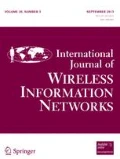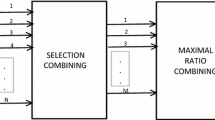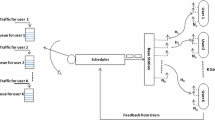Abstract
In this paper, closed-form expressions for the capacities per unit bandwidth for generalized Rician fading channels are derived for power and rate adaptation, constant transmit power, channel inversion with fixed rate, and truncated channel inversion adaptation policies. The closed-form solutions are derived for the single antenna reception (without diversity combining) and maximal-ratio combining (MRC) diversity cases. Truncated channel inversion adaptation policy is the best policy for the single antenna reception case, while the channel inversion with fixed rate policy is the best policy for the MRC diversity case. Constant transmit power policy provides the lowest spectral efficiency as compared to the other policies with and without diversity.











Similar content being viewed by others
References
Sklar B. (1988) Digital Communications - Fundamentals and Applications. PTR Prentice Hall, Englewood Cliffs, NJ
M. Alouini and A. Goldsmith, Capacity of Nakagami multipath fading channels, Proceedings of the IEEE Vehicular Technology Conference VTC’97, Phoenix, AZ, pp. 358–362, May 1997.
A. Goldsmith and P. Varaiya, Capacity of fading channels with channel side information, IEEE Transactions on Information Theory, Vol. 43, No. 6, November 1997.
M. Alouini and A. Goldsmith, Capacity of Rayleigh fading channels under different adaptive transmission and diversity-combining techniques, IEEE Transactions on Vehicular Technology, Vol. 48, No. 4, July 1999.
H. Zhang, W. Li and T. Gulliver, Capacity and error probability analysis for orthogonal space-time block codes over correlated Rayleigh and Rician fading channels, IEICE Transactions on Fundamentals of Electronics, Communications and Computer Sciences, Vol. E88-A, pp. 3203–3213, 2005.
Fozunbal M., McLaughlin S., Schafer R. (2005) Capacity analysis for continuous alphabet channels with side information. Part II. MIMO channels. IEEE Transactions on Information Theory 51(9):3086–3101
Chockalingam A., Milstein L.(1995) Capacity of DS-CDMA networks on frequency selective fading channels with open-loop power control. Proceedings of the IEEE International Conference on Communications 2:703–707
W. Choi and J. Andrews, Outage probability for maximal ratio combining receivers in asynchronous CDMA channels, Proceedings of the IEEE International Symposium on Spread Spectrum Techniques and Applications (ISSSTA), September 2004.
Jindal N., Goldsmith A. (2003) Capacity and optimal power allocation for fading broadcast channels with minimum rates. IEEE Transactions on Information Theory 49(11):2895–2909
Jayaweera S., Poor V. (2005) On the capacity of multiple antenna systems in Rician fading. IEEE Transactions on Wireless Communications 4:1102–1111
Stark W. (1985) Capacity and cutoff rate of noncoherent FSK with nonselective Rician fading. IEEE Transactions on Communications33(11):1153–1159
W. Jakes, Microwave Mobile Communications, 2nd ed. IEEE Press, Piscataway, NJ, 1994
R. Mallik and M. Win, Channel capacity in evenly correlated Rayleigh fading with different adaptive transmission schemes and maximal ratio combining, Proceedings of the IEEE International Symposium on Information Theory (ISIT’00), Sorrento, Italy, p. 412, June 2000.
M. Alouini, A. Abdi, and M. Kaveh, Sum of gamma variates and performance of wireless communication systems over Nakagami fading channels, IEEE Transactions on Vehicular Technology, vol. 50, no. 6, pages 1471–1480, November 2001.
Proakis J.G. (2001) Digital Communications. McGraw Hill, New York, fourth edition
Gradshteyn I., Ryzhik I. (1994) Table of Integrals, Series, and Products fifth edition. Academic Press, San Diego, CA
Gunther C. (1996) Comment on “Estimate of channel capacity in Rayleigh fading environment”. IEEE Transactions on Vehicular Technology 4:401–403
Author information
Authors and Affiliations
Corresponding author
Rights and permissions
About this article
Cite this article
Bhaskar, V. Spectral Efficiency Evaluation for MRC Diversity Schemes Over Generalized Rician Fading Channels. Int J Wireless Inf Networks 14, 209–223 (2007). https://doi.org/10.1007/s10776-006-0051-0
Received:
Accepted:
Published:
Issue Date:
DOI: https://doi.org/10.1007/s10776-006-0051-0




